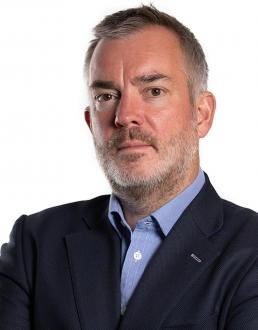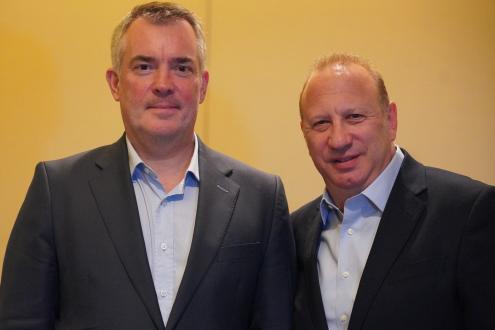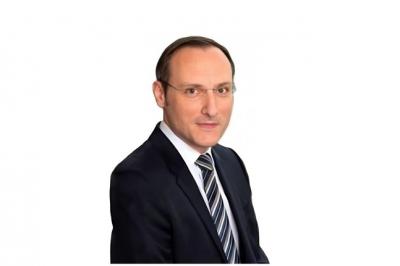GAM Investments on Finding Opportunities in European Equities

Niall Gallagher of GAM Investments
Dec 19, 2022
A Hubbis Thought Leadership Discussion, In Association with Exclusive Partner: GAM Investments
In partnership with GAM Investments, Hubbis held a behind-closed-doors discussion on November 14 in Dubai, focusing on European equities and investor strategies for the year ahead. The guests were all private bank and wealth management gatekeepers, CIOs and other decisionmakers working in Dubai.
The key speaker from GAM was Niall Gallagher, Investment Director and responsible for the management of European Equity funds at GAM Investments, who was introduced by Philip Rosenberg, Managing Director, Head of Distribution Middle East.
This is a brief summary of some of Niall’s many valuable insights and observations and is designed to provide a snapshot of his and GAM’s views on European (including UK) equities at this point in time, and to support his conclusion that stocks are very cheap, and that the bottom might be here already, or soon approaching.
Niall Gallagher on European equities
After a note of introduction from Philip Rosenberg and a welcome to the assembled wealth management experts from the region who attended the event, Niall explained that GAM runs one roughly USD1.2 billion European strategy comprising two big funds and one mandate. One fund is Europe including the UK, another is Europe ex-UK, and the mandate is European Large Cap.
He said GAM follows the same investment process for each of them, and each is quite concentrated, with plus or minus 40 stocks each. GAM’s team is long-term in view, with some stocks held upwards of 20 years.
“The goal for us is great businesses and to hold them for as long as we can,” he told guests. “And of course, there are new companies arriving all the time.”
Europe is very cheap, says GAM
Niall observed that the last 13 to 14 years since the Global Financial Crisis (GFC) have actually been very unusual, and the period we are now entering is actually a return to normality, with rates of 3% to 6%. And there is inflation, again for the first time for many years.
He said he would explain GAM’s preferred ways to invest in these prevailing and anticipated conditions. He said he believes Europe is cheap and has been most of the years since the GFC. It currently trades at around 11x earnings, a big discount to the US. And the P/BV of the European equity market is also cheap.
As to characteristics, over half of the earnings for the European equity market now come from outside of Europe. The Americas and Asia ex-Japan are about 40% of the revenues, meaning Europe is exposed to global growth as much as European growth.
The Dollar has been very strong, but for European companies in general has been great, he said, because Dollar linked revenues of the European companies are similar in size to the Euro linked revenues. He estimated that as much as 75% or more of the earnings of the German car industry are dollar related.
The earnings slowdown has not yet happened. He cited Richemont, an exceptionally good consumer proxy in Europe that only very recently had reported strong figures. “You see slowdowns in some areas directly impacted by oil and gas prices, but you're not yet seeing it, at least in the middle- and higher-income consumers,” he told guests.
Sectors in favour – banks and oil & gas shine bright
Some parts of the market that have been neglected are returning to life, such as the banks, where GAM is material overweight, buying in at 4-5 times earnings.
“The zero-rate interest environment for banks was terrible, but at 2% or 3%, deposits become profitable and that is not yet factored in,” he stated. “Names such as NatWest, Caixa Bank in Spain, Fineco Bank in Italy, Nordea, and others we expect to show over a 50% rise in earnings next year, perhaps more. And balance sheets are very conservative, because we have had so much deleveraging in Europe over the last 15 years. The banks therefore come on very low PEs, very high dividend yields and on top of that there are share buybacks and as I said, rising profits.”
Oil & gas stocks in Europe are also very cheap. Shell has about two-thirds of the earnings of Exxon, but around 40% of the market cap. It trades on about 4x or 5x earnings. GAM expects high prices to stick because the world is not investing enough in new fields.
“We started buying banks at the end of 2020, ditto oil and gas,” he explained. “We saw mispriced stocks and we believed the market was not seeing a major inflection in earnings to come.”
Europe’s deep pool of world class companies across many sectors
World class companies are abundant. “There are some great businesses, which are global, which are exposed to many of the key structural growth trends we see in the world,” Niall stated. For example, the Asia theme of growth can be captured in stocks such as LVMH, MonclerF, Pernod Ricard, Diageo, or L’Oréal. “These are some of the best franchises amongst the upper middle class in China and rising in other parts of Asia too.”
Amongst other world-class names in different sectors are stocks such as Atlas Copco, ASM International, ASML, Straumann Novo Nordisk, amongst others.
GAM likes the auto sector, through names such as Stellantis in France, formed in 2021 on the basis of a 50-50 cross-border merger between the Italian-American conglomerate Fiat Chrysler Automobiles and the French PSA Group (which owns Peugeot, Citroen, Opel, and Vauxhall). “They trade at about 3x earnings, which are growing,” Niall stated.
In the UK, GAM likes global stocks such as RTZ Corporation (Rio Tinto), one of the world’s owners of the best industrial assets, and commodities such as copper and aluminium, which GAM believes will stay expensive for the foreseeable future. Another global stock is Diageo, the multinational beverages and alcohol business. GAM generally avoids domestic UK stocks and Niall observed that the UK economy will be a tougher environment than the rest of Europe looking ahead, due to the confluence of high energy costs, rising interest rates, and rising taxes.
GAM’s bottom-up analytical approach
GAM is 80% to 90%, bottom up, with a keen eye also on top-down inputs. They are largely benchmark agnostic. From a portfolio construction or risk management perspective they employ factor models, such as Barra to make the funds highly stock specific, and to make sure they avoid excess concentrations of factor risk in the portfolio. And as to risk management within the GAM strategy, he explained that although UCITs rules allow for up to 10% in any on stock, GAM feels comfortable at a maximum of around 6% to 7%.
The many appeals of the European markets lead Niall to report he has 100% of his portfolio in the two funds. “We think in many cases, the upside is a multiple, rather than a percentage, and there are certainly good companies with rising returns and deep value, and businesses that are growing quickly and have higher returns, are world class in what they do. This is a time that is cheap in terms of entry, based on a historical perspective.
ESG plays an increasingly prominent role in GAM’s analysis
Niall explained that GAAM adheres willingly and avidly to the ESG regulations cover UCITs funds, as championed by Europe’s SFDR categorisations and associated disclosure requirements. He explained that the ambitions and targets related to ‘E’ form a key part of their analysis, and so too ‘G’ for governance is vital as companies must be seen to be acting in the best interests of stakeholders. He said the ‘S’ is more open to interpretation and requiring a more individualised judgement.
Another major trend is energy transition
Following on from his ESG comments, Niall explained that another major trend is what he termed ‘energy transition’, which opens another major investment route. To achieve the 1.5-degree reduction in temperatures worldwide, he cited a McKinsey report that stated that global physical capex needs to rise from 6.8% of GDP to 8.8% of GDP by 2030.
“Our physical assets are depleted worldwide, whether it is infrastructure, or energy systems, or buildings, and a vast amount of the existing physical capital also needs replacing over the next 30 to 40 years if we're going to hit net zero,” he reported. “The numbers are almost mind boggling, and that creates great opportunity for all sort of companies.”
As just one example, Niall referred to the Italian firm Prysmian, a maker of high voltage cables, which are of course so vital for moving power for example from wind or solar farms. He pointed to a favourite project in Australia, an investment to achieve 20 terawatts of solar producing assets in the Northern Territories and then to construct three 4000-Km high voltage electricity lines to Singapore and to supply 15% of Singapore's needs from there. “If they do that, they will need about 12,000-KM of cable,” he reported.
Although the objective is to wean off oil and gas, Niall said this will not be possible until renewables are much more advanced, because of the risks of low wind power generation, periods of reduced solar power and so forth. “The reality is we're going to need gas for quite some time, at least a decade or two, and that will require more gas infrastructure, at the same time as rapidly expanding in renewables,” he stated. “Hydrogen power is interesting but storage costs as colossal.”
Rates – every way is up?
Niall replied to a question from the guests on his predictions around rates. With inflation of well over 10% in many European countries, rates are likely to rise further, but perhaps not dramatically in Europe.
“I think getting to 3% looks likely, with the ECB then maybe stopping for a while to see what happens,” he opined. “Beyond that, my guess is inflation will probably peak and come down a bit. We are not however going back to the deflationary world of the past 15 or so years. In short, if I had to put a put a number on it, rates are likely to peak somewhere around 3% in Europe, maybe a bit more, and then settle in a range in Europe between 1% and 3%. Maybe the UK will go a bit further, more like 4% to 4.5%, and the US maybe even more than that, because it is a stronger economy.”
He added that the ECB has been well behind the curve, but they now have a juggling act not to hike rates at speeds or to levels that could cause a significant rise in unemployment, but not cause a major recession. “My view is 3% would be tough, but their rhetoric is such that they could go beyond that if inflation is really tough to shift.”
Closing observations – the timing is looking increasingly good
The discussion covered a host of other areas in an interactive dialogue, but Niall concluded that while there could be more turbulence and further bounces and falls in coming months in European equities, the market appears to be moving close to the bottom. He said nobody can predict what sort of events or volatility lie ahead, but what they do know is that equities in Europe are already remarkably cheap.
A Word on Niall Gallagher, Investment Director
Niall Gallagher is Investment Director at GAM Investments, and responsible for the management of European Equity funds.
Prior to joining GAM Investments in November 2009, he worked as a portfolio manager managing Continental and pan-European equities at T. Rowe Price for two years. Before that, he was at BlackRock for nine years managing both Continental and pan-European equity strategies. He began his career as an economist at the Bank of England. Niall holds a BA in Economics from Manchester Metropolitan University, an MSc in Economics and Finance from Warwick University, and is a CFA charter holder. He is based in London.
And a brief note on Philip Rosenberg
Philip Rosenberg is Managing Director and Head of Distribution - Middle East. He looks after regional institutional, private wealth, and wholesale relationships. Philip has been involved with asset management distribution for over 33 years, including fixed income, equities, and alternatives. He joined GAM Investments in 2010 and has been connected to the firm since 1998. Before joining GAM, Phil was an Executive Director at Julius Baer in the Middle East team. He also worked at EFG Bank, advising clients in the US, Middle East, and the UK. Before this, he held senior distribution and marketing roles at Liberty Ermitage and Credit Lyonnais. He started his career at Lehman Brothers in 1989, where he was a pioneering member of the alternatives investment team. Philip studied sound engineering and music technology and holds CFA UK Certificate in Investment Management (IMC) and CISI Level 6 qualifications. He is based in London.
DISCLAIMER FROM GAM
For institutional, professional investors and financial intermediaries only and not for retail or public use.

Investment Director at GAM Investments

More from Niall Gallagher, GAM Investments
Latest Articles






